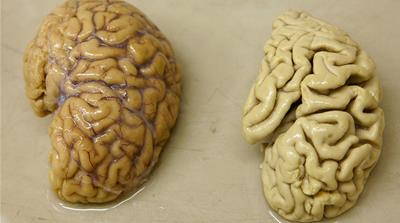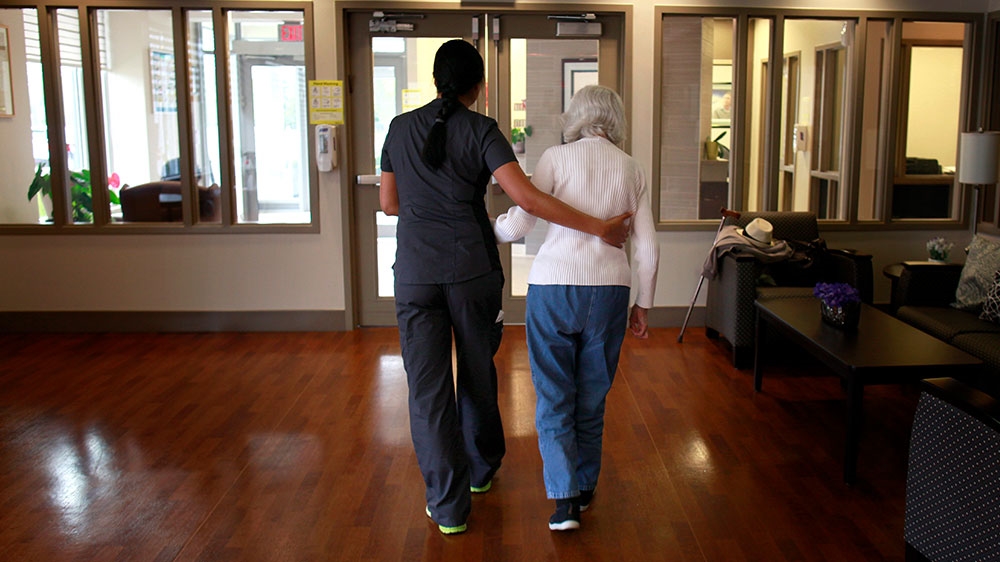Alzheimer’s Day: The journey of caring for one with the disease
Sheila often thinks back to the day more than two decades ago when her mother, Theresa, sat with her in the driveway outside her home in Kentucky and told her she had taken out a long-term care policy “just in case”.
“If I get this disease, I’m telling you right now that I don’t want to live with my children and I don’t want to be a burden,” Sheila, who asked Al Jazeera to withhold her surname, recalls her mother saying at the time.
Ten years passed before the signs gradually appeared.
At first, Sheila says, her mother would just repeat some stories. But then, there were things she would completely forget. Eventually, in 2007, Theresa displayed behaviours that were hard to ignore. That’s when Sheila, as well as her two brothers and father, knew it was time for Theresa to be checked out.
More than 50 million people worldwide live with dementia, defined by the Alzheimer’s Association as “a decline in mental ability severe enough to interfere with daily life”. The most common type is Alzheimer’s, a disease that causes memory loss and changes in behaviour that often get worse over time.
At least 5.7 million people in the United States live with Alzheimer’s, and experts expect the number of those diagnosed to more than double in the next 40 years. But Alzheimer’s does not afflict only those who are living with the disease; it often affects family members and other caregivers the most, placing far-reaching financial, physical and emotional burdens on them, often in unexpected ways.
 |
| About 16.1 million people in the US provide 18.4 billion hours of unpaid care to those living with dementia, the Alzheimer’s Associate estimates [Ben Margot/AP Photo] |
According to the Alzheimer’s Association, 16.1 million people in the US provide unpaid care for someone living with Alzheimer’s or some other form of dementia. That equates to about 18.4 billion hours of care, which is valued at an estimated $232bn.
“Compared with caregivers of people without dementia, twice as many caregivers of those with dementia indicated substantial emotional, financial and physical difficulties,” the Alzheimer’s Association says.
Coping with the signs and diagnosis
Sheila considers herself blessed because her mother, recognising the risk due to their family’s history of the disease, somewhat prepared her for what was to come.
After the diagnosis, Theresa, who lived in an assistant-care facility, would ask to go home with Sheila and spend the night. Because Theresa didn’t sleep well and would wander by herself, Sheila knew it was too dangerous and would have to say no.
“That would be heartbreaking, but I knew that’s what mom would have wanted me to do because she already told me,” Sheila says, still finding comfort in that conversation in the driveway more than a decade earlier.
Health professionals say such conversations are important, not only for the person diagnosed, but for the caregivers who live with the disease as well.
When signs like memory loss that disrupts daily life, problem-solving challenges, confusion over time, changes in mood and personality begin to appear, the individual should be checked by a doctor, according to Ruth Drew, the director of Information and Support Services at the Alzheimer’s Association.
 |
| Early signs of Alzheimer’s include memory loss, difficulty completing familiar tasks and changes in personality or behavouir [Tyrone Siu/Reuters] |
If a diagnosis is made, Drew says, it is important for caregivers to become informed about the disease itself.
Research has come a long way when it comes to understanding Alzheimer’s, which was first described in 1906 by German physician Alois Alzheimer, who documented a female patient’s “profound memory loss” and other psychological changes. After examining the women’s brain following her death, Alzheimer found abnormal clumps, “dramatic shrinkage” and tangles of twisted fibers, according to the Alzheimer’s Association. Researchers now know those clumps are made up, in part, by beta-amyloid, a “novel cerebrovascular amyloid protein”, that triggers cell damage. The twisted fibers are made up of a tau protein, which also contributes to cell degeneration.
 |
| One hemisphere of a healthy brain (L) is pictured next to one hemisphere of a brain of a person suffering from Alzheimer disease [Denis Balibouse/Reuters] |
In 1987, researchers identified the first gene associated with the less common, inherited forms of the disease. Six years later, they identified another gene that raises the risk of developing the disease. By 2013, at least 20 genetic variations were identified that were associated with an increased risk of Alzheimer’s.
Researchers also now know that changes in the brain begin long before signs of the disease appear. Alzheimer’s itself, however, affects individuals in different ways. For some, like Theresa, it progresses slowly and over time the symptoms become more pronounced. For others, an individual’s behaviours and memory can change quickly, making the person almost unrecognisable shortly after a diagnosis.
That’s why, according to Drew, it’s important for families to plan ahead and discuss different scenarios and how best to cope the different stages of the disease early on.
“When people are diagnosed early they can have a voice in what follows, and they can make decisions and share with their family what they want, which is such a gift,” Drew says. “They can also live the best version of their lives that is possible,” she adds.
Sheila speaks of that gift.
She recalls the time when the family decided they needed to take away her mother’s chequebook because Theresa, who had always been a generous person, would write cheque after cheque to different organisations that would send letters asking for donations. Not long after this, Theresa called Sheila, saying she couldn’t find her cheques anywhere. That was the moment, Sheila, whose Christian faith had always been a big part of her life, knew that she would have to lie.
“Then it was just lie after lie after lie,” she says, finding comfort in knowing that this is the care her mother said she would want – to take measures to keep her calm – and praying that God knows they are not lies of intent.
Support for a ‘rainy day’
Sheila and Drew agree that groups and other support systems are also important ways for family members and others touched by the disease to cope.
Deborah Rubenstein, a social worker and the director of client relations at Iona Senior Services, is a support group facilitator in Washington, DC.
“It’s important that family and friends know that this is a loss for you. This is a really difficult and painful process,” she says.
“Support groups [can be] a wonderful resource because nobody understands the way people who’ve been going through it understands it.”
 |
| Health professionals say it’s normal for the disease to get to a point when a family may no longer be able to provide the needed care to someone living with the disease [Marta Iwanek/Toronto Star/Getty Images] |
Rubenstein explains that individuals commonly cope with the feeling of guilt, especially when decisions about care must be made. In one of her support groups, a woman whose husband was living with dementia became so overwhelmed that she knew she needed extra help. But the woman felt guilty dipping into the money the couple had saved because they had put it aside for a “rainy day”, Rubenstein says. After consoling the woman, it was the support group that convinced her this was the couple’s rainy day.
Sheila says she attends support groups, but also found comfort in calling the Alzheimer’s Association’s helpline, which is staffed 24/7 with professionals who can answer questions about the signs of the disease, caregiving tips and provide resources to help guide family members through the process.
Will there be a cure?
Although research has improved, especially over the last 20 years, Alzheimer’s remains the sixth leading cause of death in the US. It is also the only cause in the top 10 that cannot be prevented, slowed or cured, according to the Alzheimer’s Association.
Despite the grim reality of the disease, the Alzheimer’s Association’s Drew says researchers are getting closer and closer to a number of drugs that may help treat the disease.
“While it doesn’t sound like there’s going to be this magic bullet cure that you just take this pill and presto change, no more Alzheimer’s,” Drew says. “It sounds more like there may be drugs that help clear the plaques and tangles … or that help prevent [them] from forming.”
 |
|
Alzheimer’s remains the sixth leading cause of death in the US [Tyrone Siu/Reuters] |
According to the Alzheimer’s Association, there are five drugs approved by the US Food and Drug Association that treat symptoms of the disease. A number of drugs are also currently in the research stage that target the proteins that make up the clumps and tangles, Dr Alzheimer first found more than a century ago.
For families and other caregivers of those already living with the disease, however, they must look for comfort and support outside the developing treatments. For many, the journey, including the financial and emotional burden, can be hard, sometimes ripping families apart. But for others, there are small moments that they can take comfort in.
Sheila says her’s and Theresa’s faith has been a major component of their journey with Alzheimer’s. Sheila takes comfort in knowing that her mom is still witnessing Christ, even with the disease.
“When some of the caregivers [at her facility] are having a bad day, and my mom doesn’t know that, the Lord uses her to just walk up to them and give them a hug and kiss and say, ‘I love you’,” Sheila explains.
It is through those small moments, too, that Sheila is able to cope.
“In the last couple of weeks, we were just sitting in her apartment together, listening to music,” Sheila recalls.
“All of the sudden mom just looked at me and she said, ‘You are so pretty’ and it just took me back,” she says.
“It was just a sincere moment of clarity of ‘I know who you are and you are so pretty.'”




